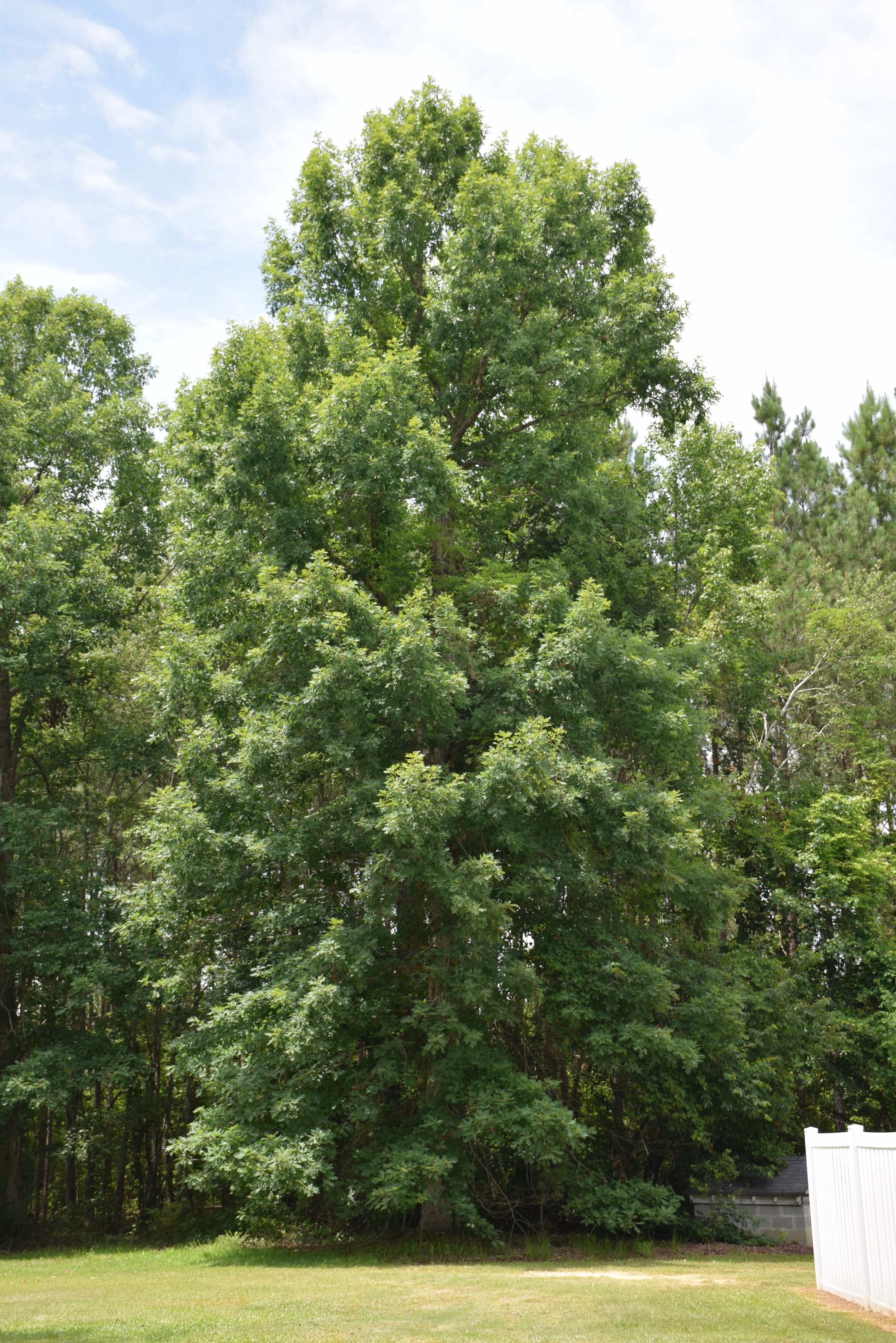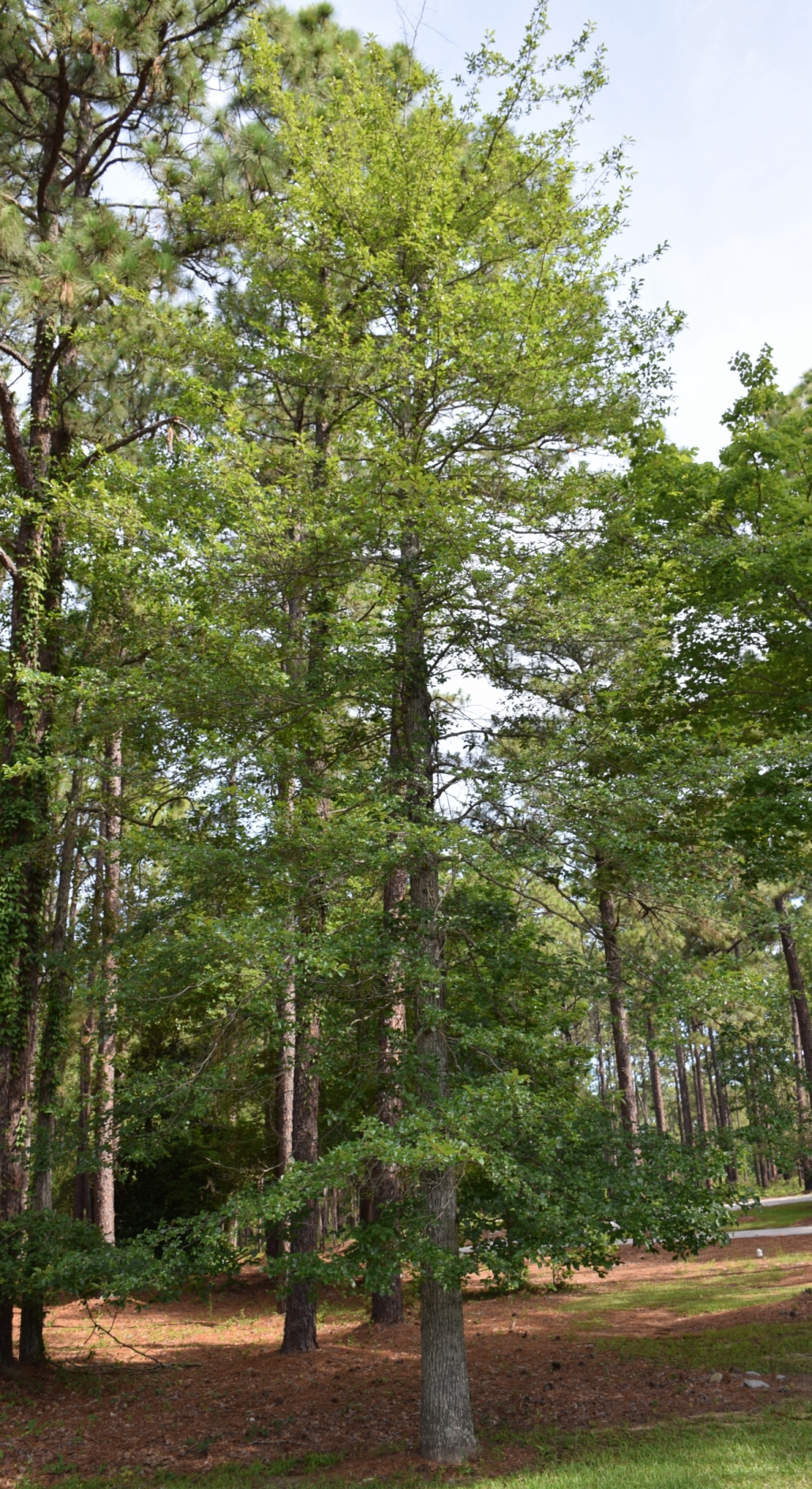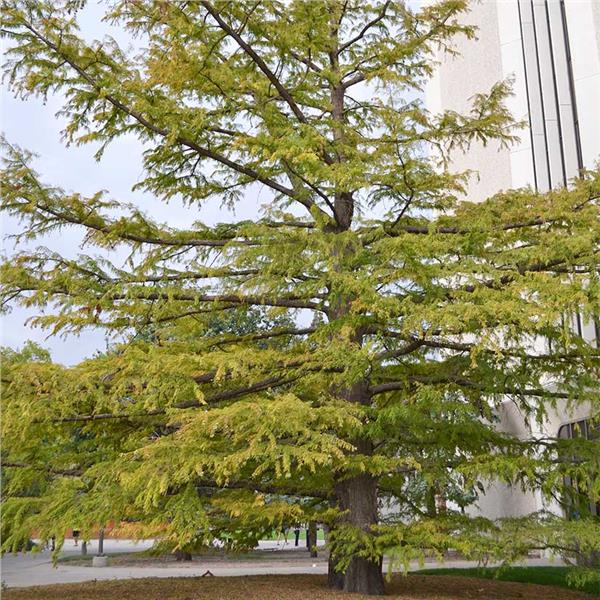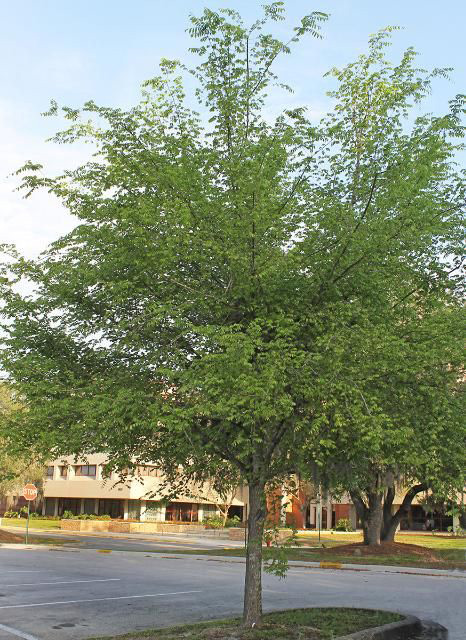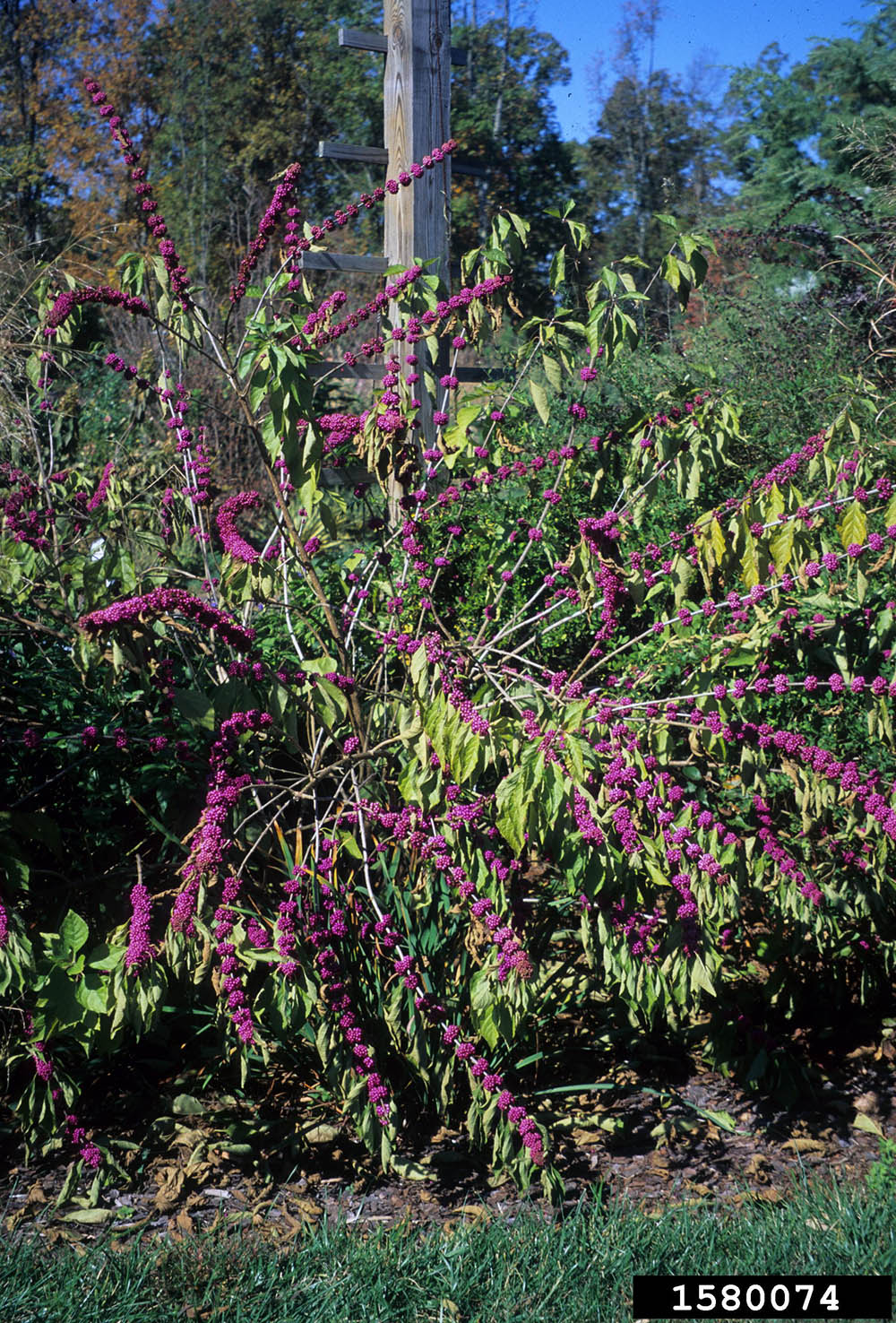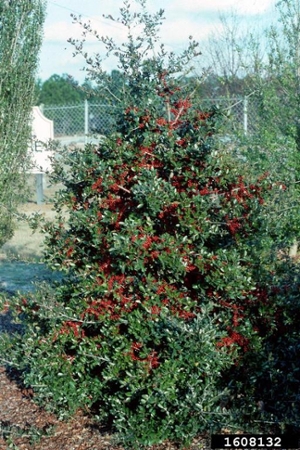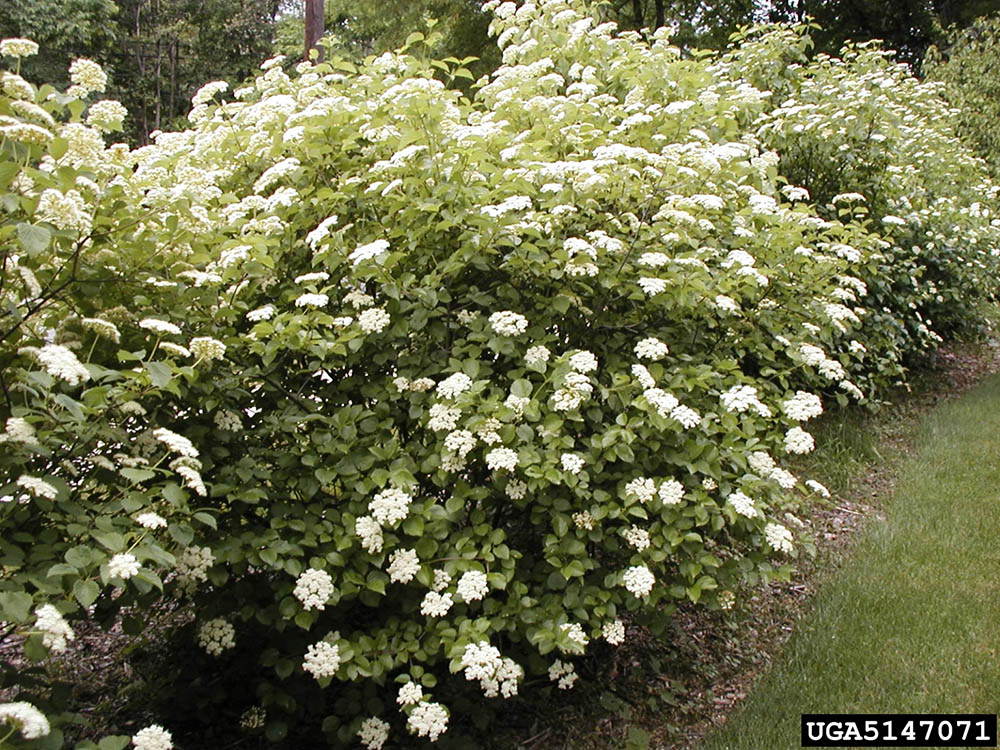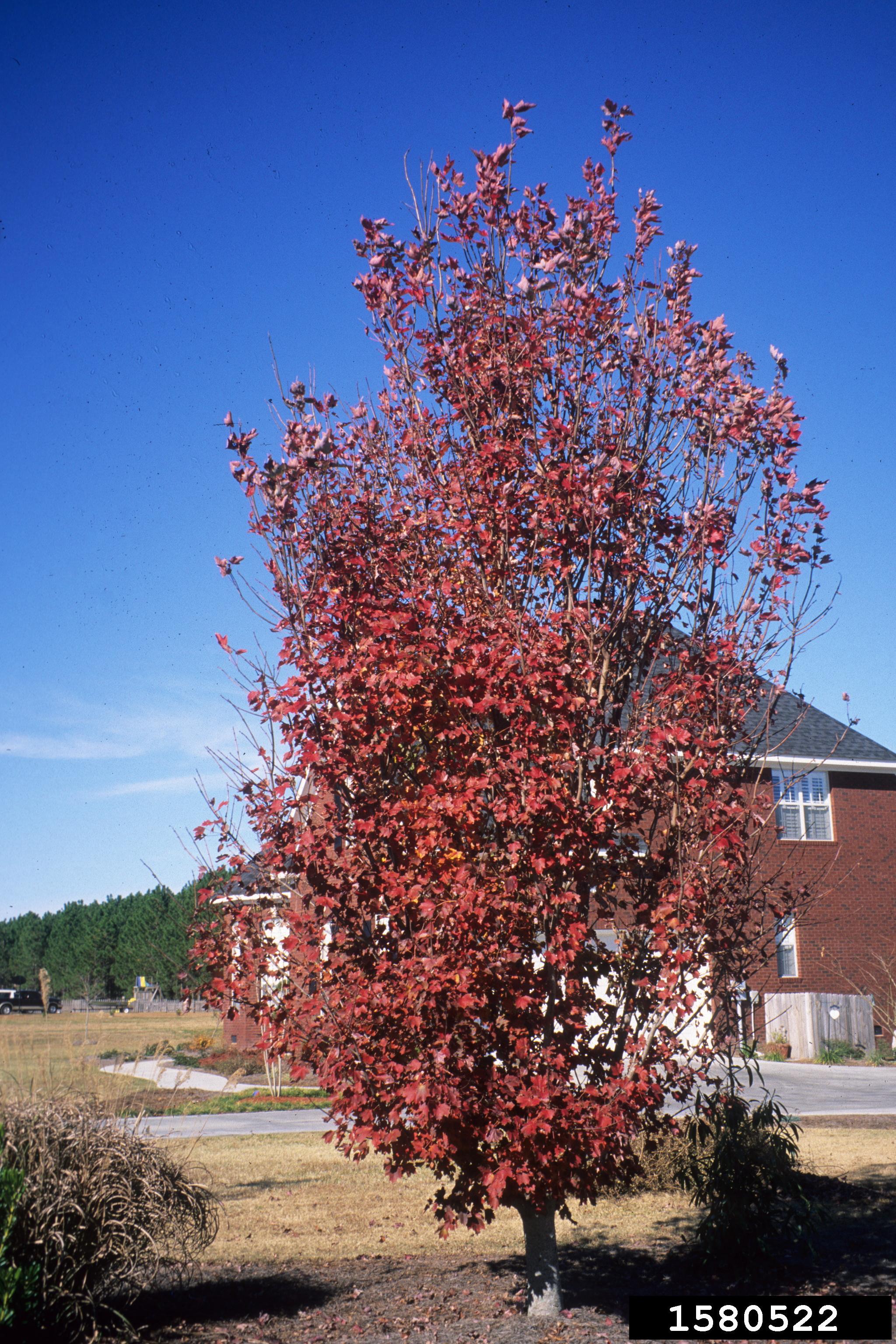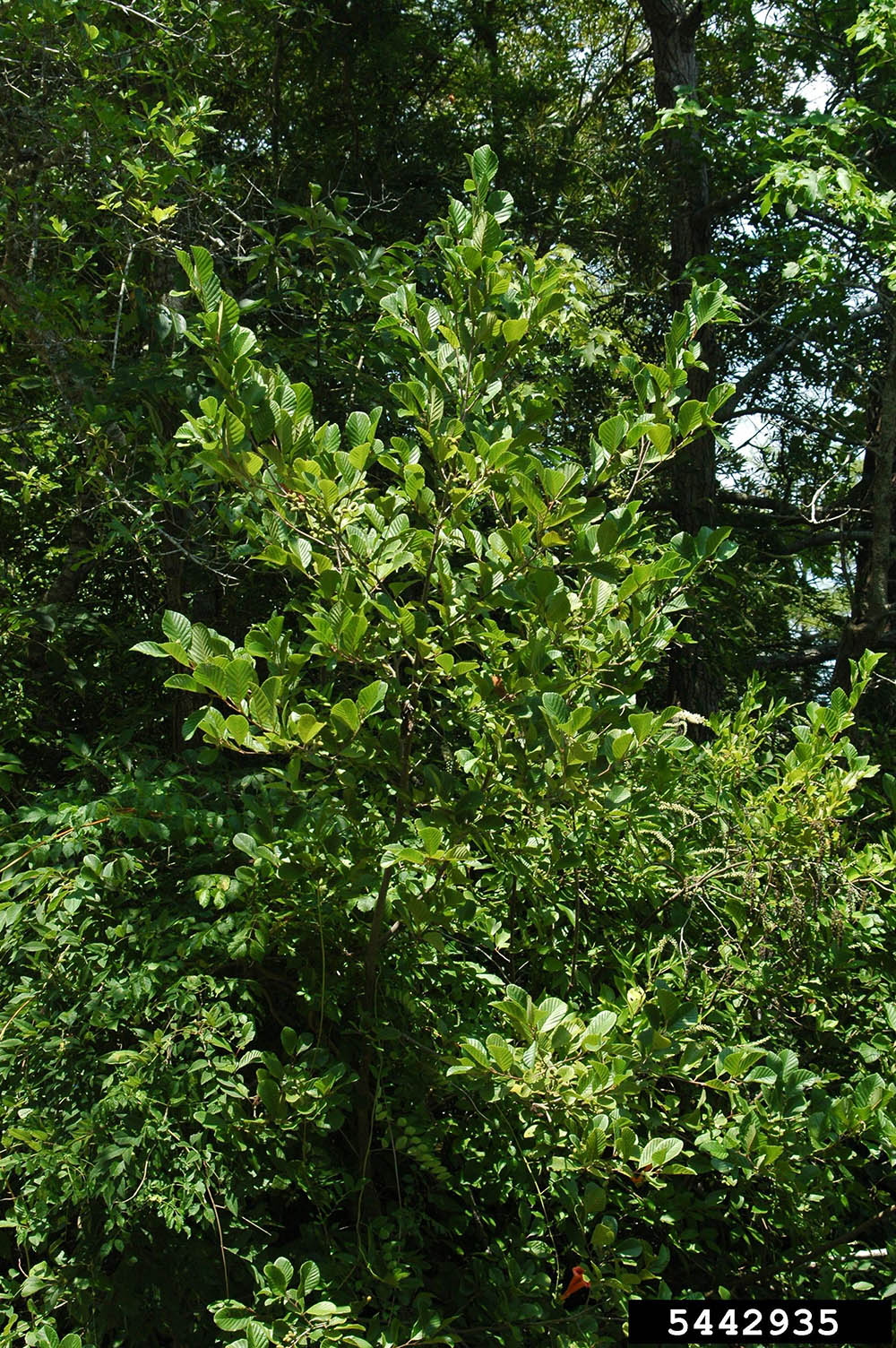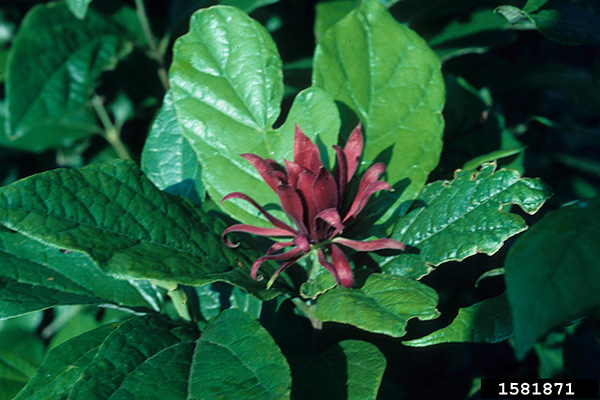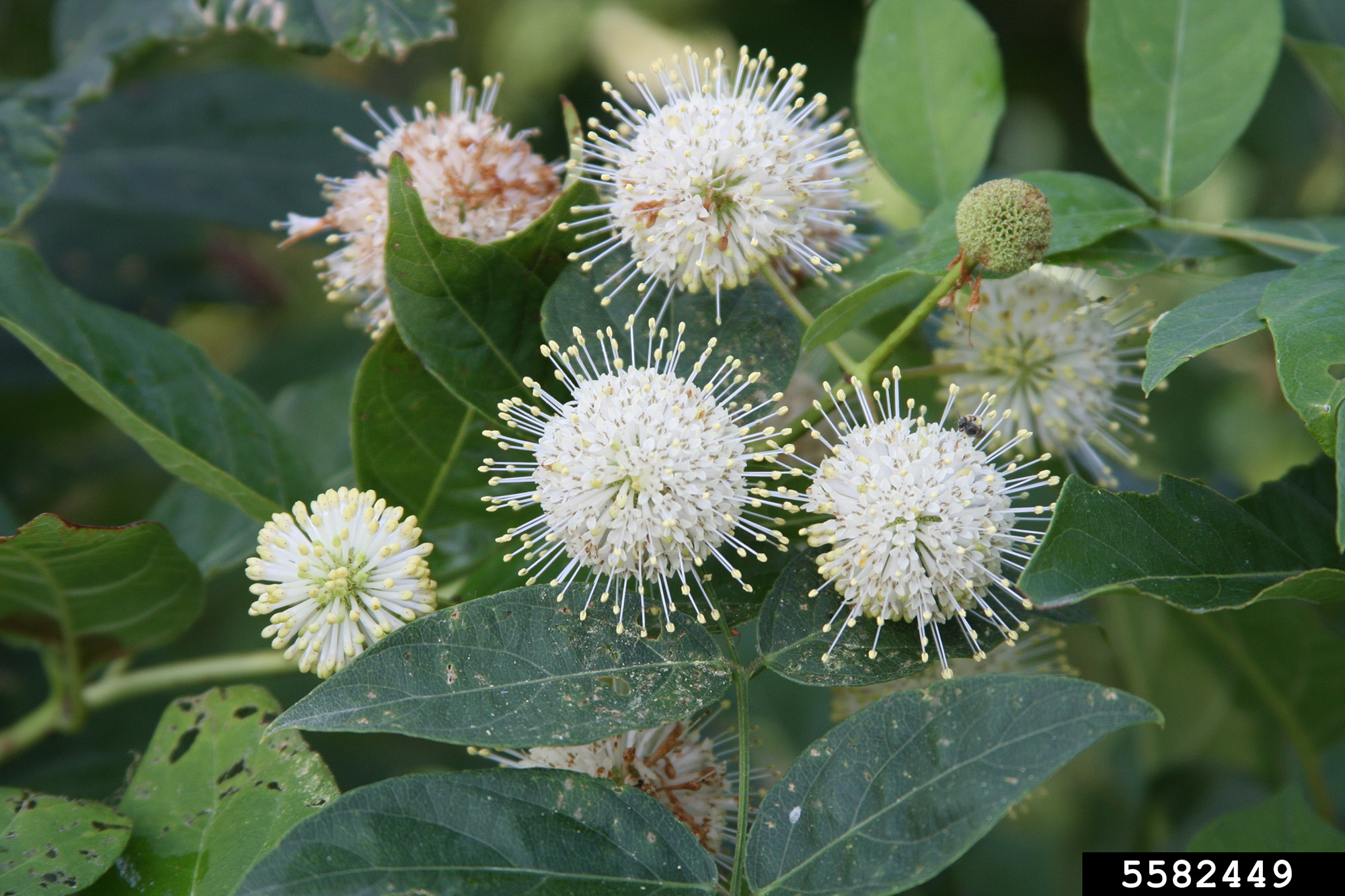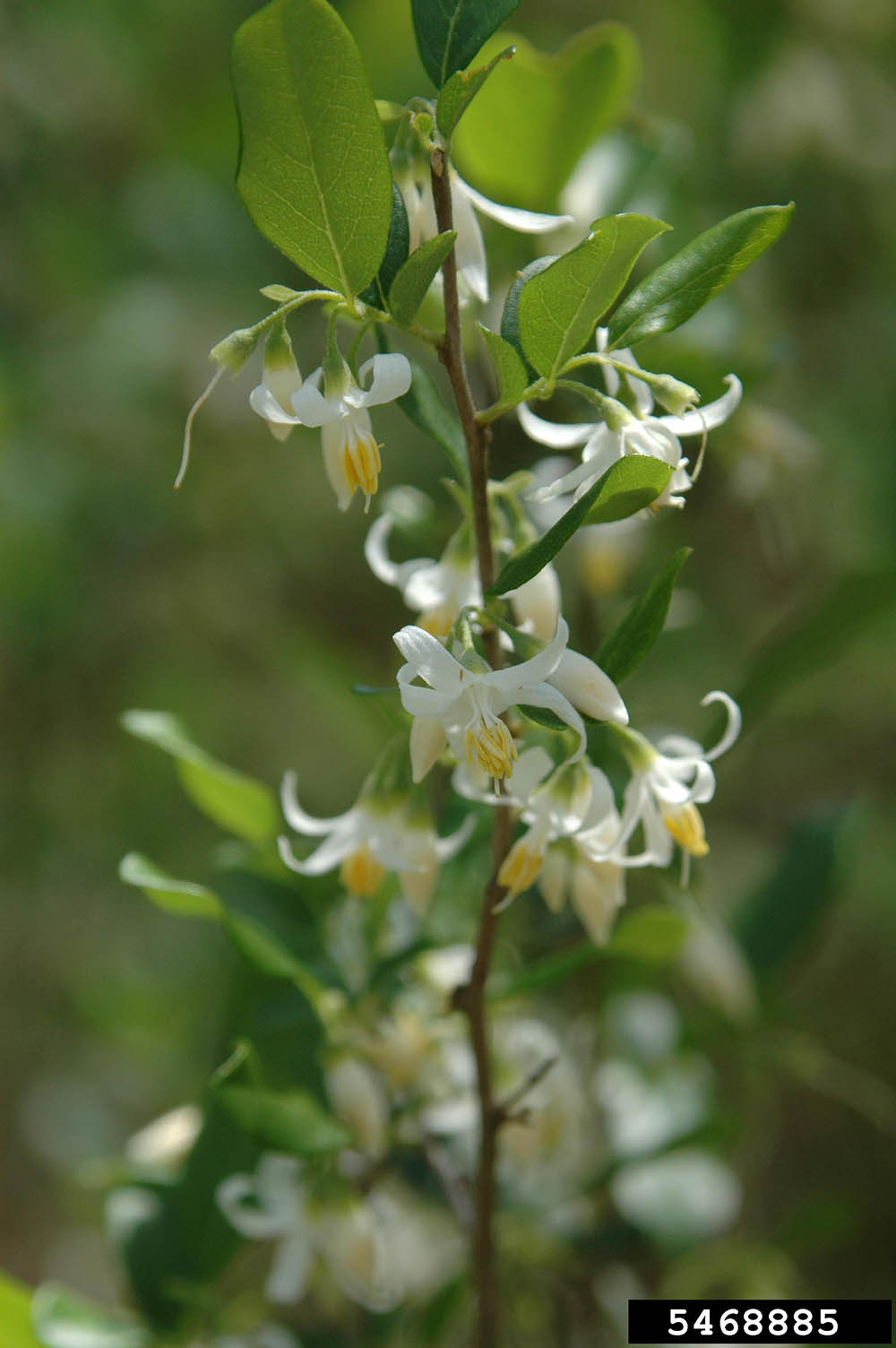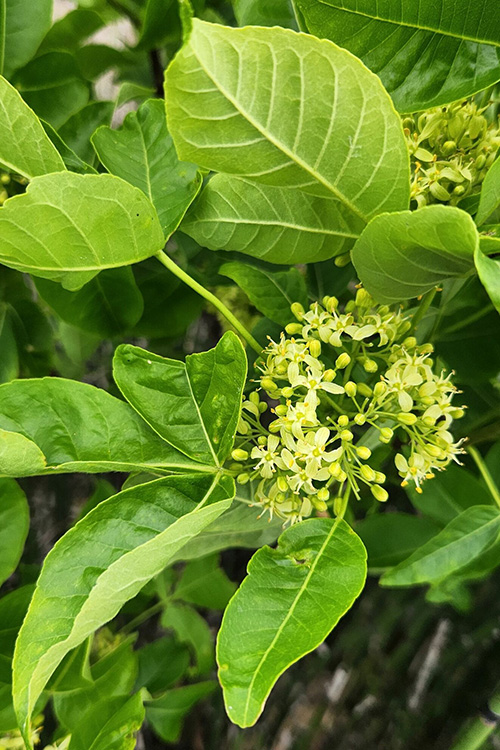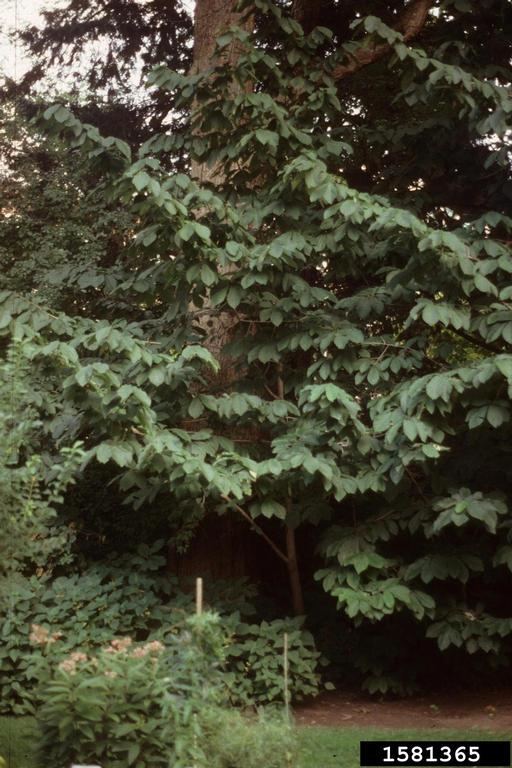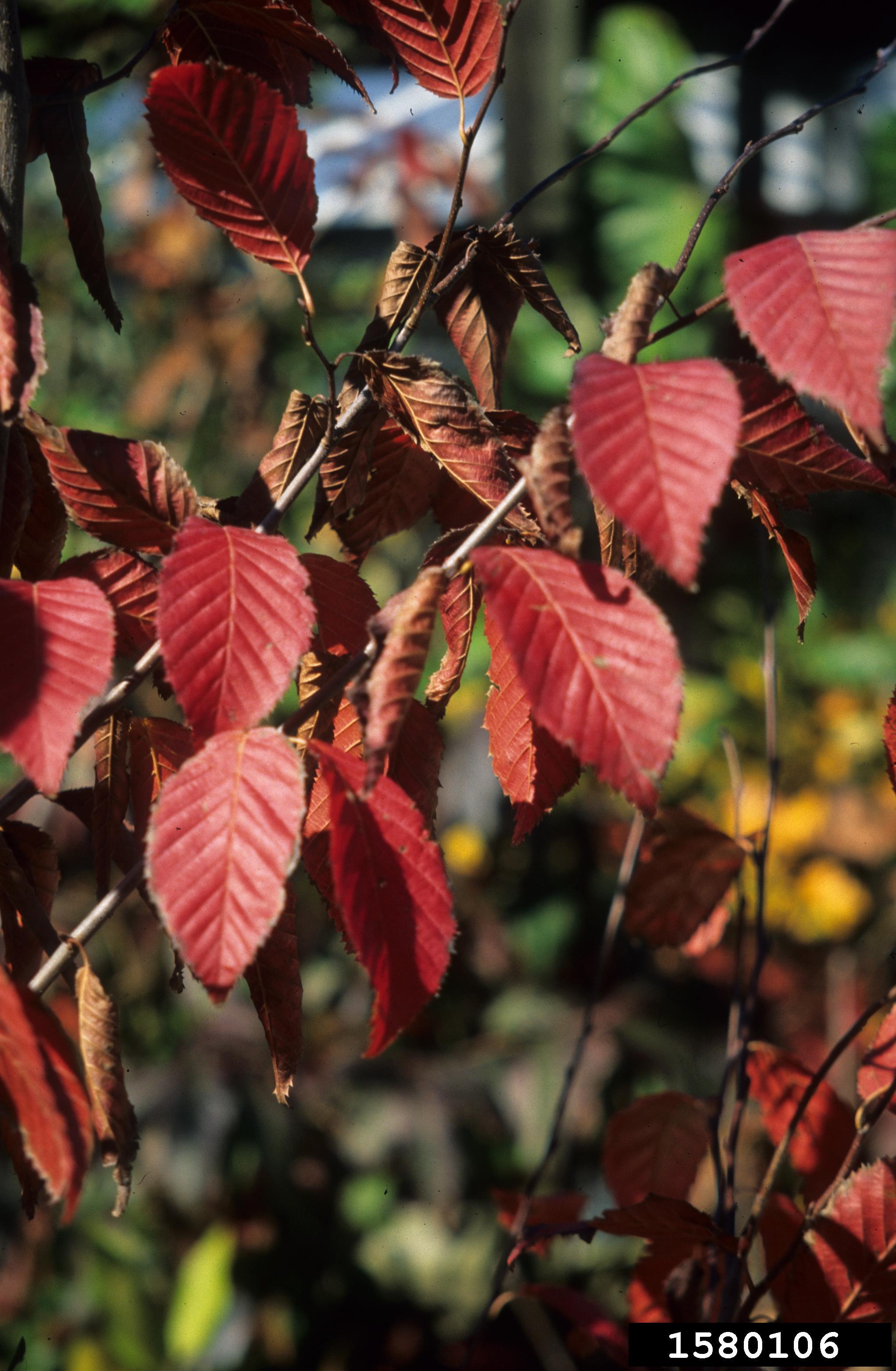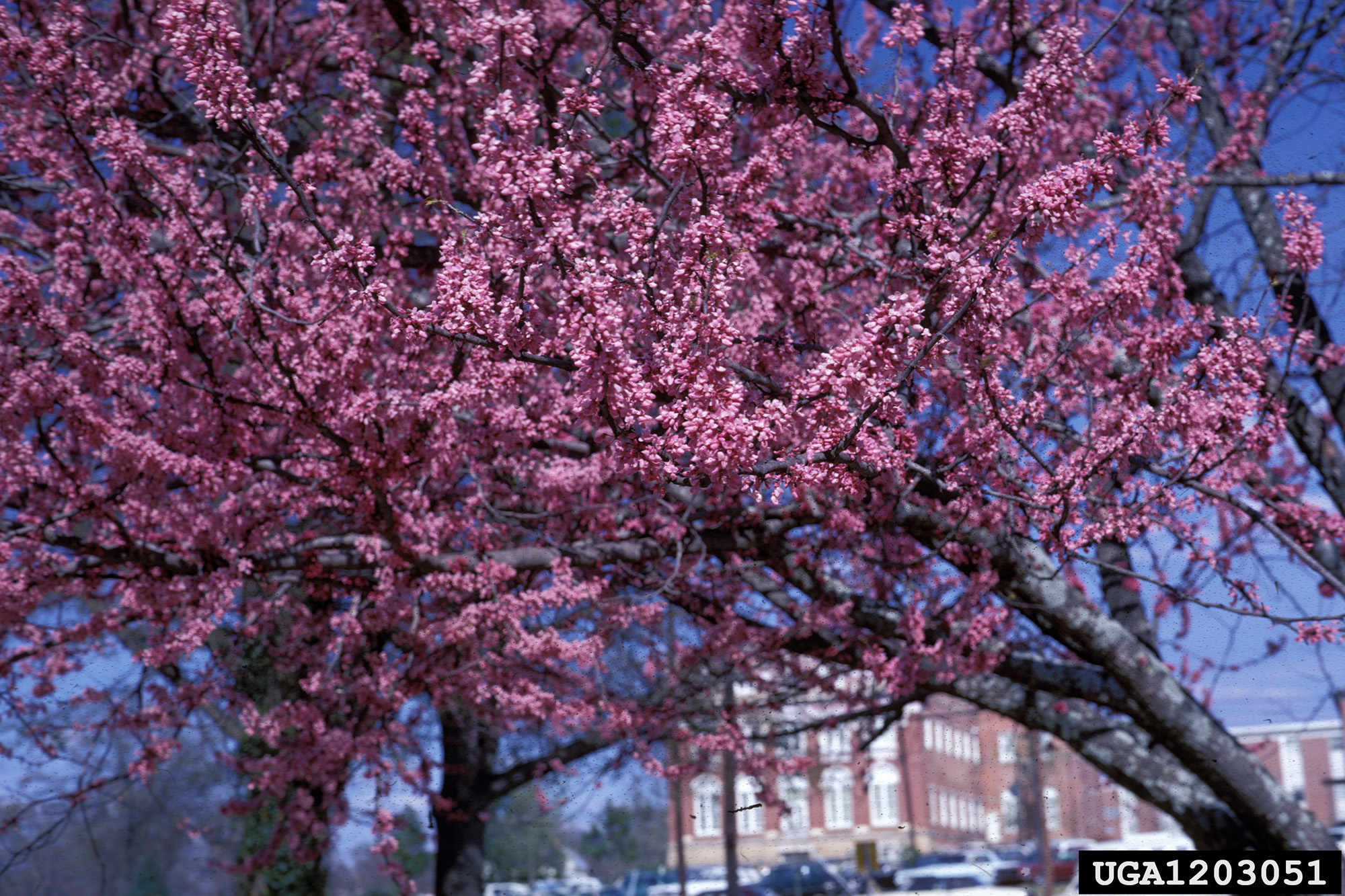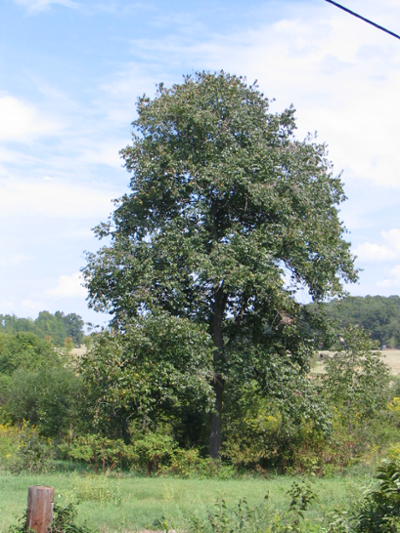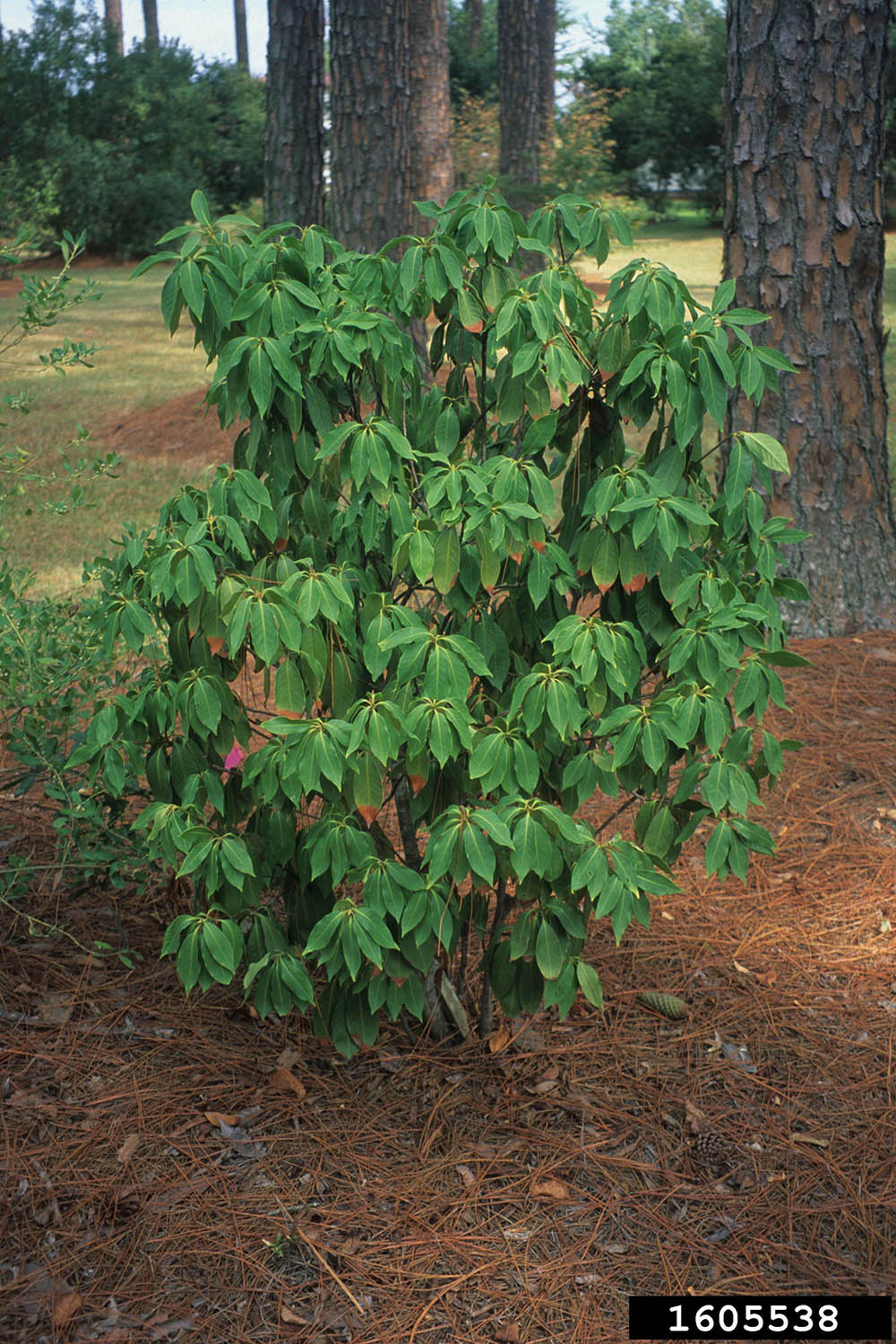Replacement Trees
Replacement trees will be distributed on a first-come, first-serve basis while supplies last. If your preferred replacement tree is not available at the time of distribution, you will be provided with a healthy alternative. Specific tree species cannot be reserved ahead of the event.
Florence - March 1, 2025
- White oak (Quercus alba)
White oak is a massive, long-lived stately tree with a wide-spreading, horizontally-branched crown that boasts an exquisite, wine-red fall leaf color that later fades to winter shades of brown. This native reaches grows to 80-100 feet in the wild and 60-80 feet tall and wide in the urban environment, providing ample shade for larger landscape spaces. Shiny, bright green leaves have finger-like lobes, and large, acorn fruits that are largely commonly consumed by squirrels, woodpeckers, turkey and white-tailed deer. Numerous butterflies use white oak as a host tree. Bark is ash-gray and scaly on young trees and ridged and platy on older trees. White oak is fairly adaptable, grows very well on most urban sites, preferring sites offering full sun and rich, well-drained soils.
- Blackgum aka: Black tupelo (Nyssa sylvatica)
Black gum is a striking medium-large canopy tree with strong horizontal branching and a stout, central trunk, growing 40-60 feet in height with narrow spread of 15-20 feet. Young trees are consistently triangular. Attractive, dark green and glossy summer foliage transitions to a vivid display of scarlet red during fall. Clusters of small, bluish-black berry fruit produced, supplying an abundant food source for wild turkey, bobwhite quail, wood ducks and over 30 species of songbirds. Blackgum prefers full sun but will tolerate dappled shade.
- Bald cypress (Taxodium distichum)
Bald cypress is a large, needle-leaf, cone-bearing tree with a pyramidal shape, spreading crown and soft, feathery leaves. It reaches heights of 70-100 feet with narrower spread of 20-35 feet. Although this tree occurs in moist-wet soils, naturally, it is a superior selection in the urban environment, lending great versatility and tolerance of harsh, urban conditions, including heat, drought, diseases, and variable soil moisture. Bark is thin, fibrous, and light gray to reddish-brown. Small, one-inch, rounded cone fruits are produced each year, and fall color reveals a lovely, rich, bronze-reddish color. Bald cypress can be planted in full sun or partial shade.
- Southern Magnolia (Magnolia grandiflora)
Southern Magnolia is a beautiful, large canopy evergreen shade tree known for its colossal-sized creamy-white flowers and their sweet fragrance. Southern magnolia has a pyramidal form and is an extremely large tree, typically growing 50-100 feet in height and 30–40-foot spread. Glossy evergreen leaves are smooth and leather-like attach to deeply stout twigs and branches. Six-petaled, showy flowers are cup-shaped and grow to 8 inches. Flowers bloom in summer and extend into fall. Conelike seed pods develop after flowering that host large, bright red colored seeds that are favored by various species of birds and small mammals.
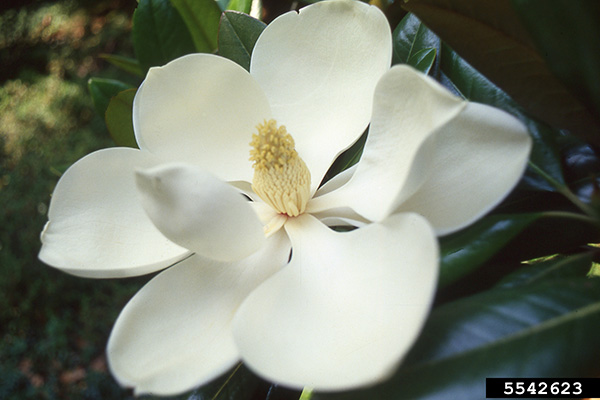
Southern Magnolia
Image courtesy of Davis Syndor - Winged elm (Ulmus alata)
A deciduous, fast-growing medium to large sized tree with oval to rounded form and distinctive corky, wing-like outcropping on twigs and branches. The mature size ranges from 40-60 feet height with canopy spread of 30-40 feet. Winged elm has rich, dark green, elliptically shaped leaves that feature a paler underside and a double-serrated (toothed) margin. Leaves are rich, dark green with a paler green underside and pubescent, sandpaper-like texture. The fall color is an attractive yellow. Small, rounded, lightweight samara fruit (one-seeded winged fruit) are produced each year. The attractive bark is gray, brown with flat ridges and fissures. Winged elm is a very adaptable tree, performing well in a range of soil conditions, including clay, loam, acidic or alkaline, wet or well-drained soils. It is especially tolerant of drought, compaction, and dry, rocky soils. Wood is strong and breakage resistant. Plant winged elm in full sun or part shade. Some structural pruning is needed to maintain a strong, central trunk. Winged elm makes a fine addition in the landscape as a nice, attractive shade tree and benefits wildlife, in particular, insectivorous birds, small mammals, and the Question Mark butterfly.
- Carolina cherry laurel (Prunus caroliniana)
The Carolina cherry-laurel is a multi-stemmed shrub that can grow to 35’ tall. It can be planted in full sun or partial shade. It is moderately salt tolerant and drought tolerant once established. It is also deer tolerant. It will self-seed in the landscape, so it can be a great hedge or border tree. It attracts pollinators and birds with fragrant, white flowers in the spring.
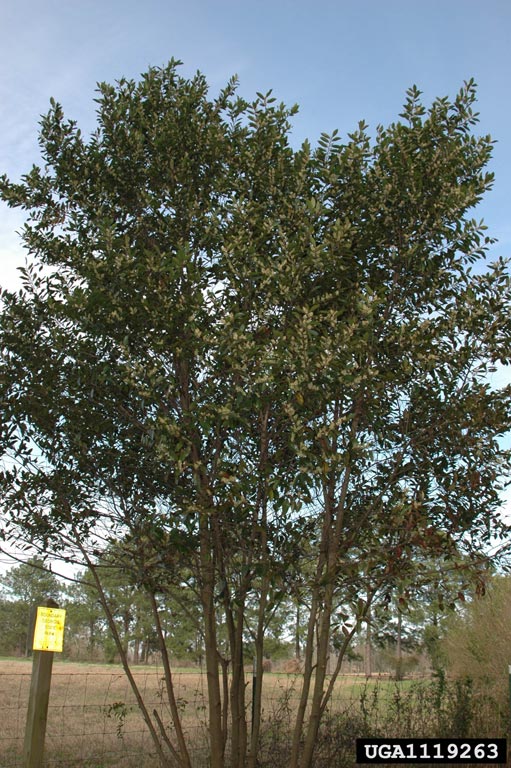
Carolina cherry laurel
Image courtesy of James H. Miller & Ted Bodner, Southern Weed Science Society, Bugwood.org - American beautyberry (Callicarpa americana)
A large, native shrub known for its striking, iridescent pink to purple fruit that clings to its long, arching, woody branches. American Beautyberry typically grows to a height and spread of 3-5 feet, though it can reach a maximum height of 9 feet. Tiny, whiteish-pink flowers form in dense clusters at leaf bases around stems. Smooth bark appears reddish brown on younger stems later fading to a light brown color. Elliptically shaped leaves, popularly browsed by white-tailed deer, fade to a light green to yellow fall color. Seeds and berry clusters are important foods for many species of birds, particularly the Northern Bobwhite.
- Yaupon holly (Ilex vomitoria)
A small evergreen tree with shiny green, elliptical-shaped leaves and strong, upright, dense branching, making it an ideal selection as a screening or privacy species. Yaupon holly typically matures to a size of 10-20 feet in height and spread of 8-12 feet. Growth rate can be slow to moderate. Copious amounts of attractive, bright red berries are produced by female trees, most popularly sold in nurseries. Yaupon holly is a versatile little tree that transplants easily and tolerates a range of soil types, including both dry and wet soils, drought, and occasional flooding. Plant in full sun or part shade.
- Arrowwood viburnum (Viburnum dentatum)
A Southern native shrub that typically grows 6-8 feet in height and spread, though sometimes taller, with a rounded, spreading crown consisting of multiple, arching stems. Attractive, flat-topped clusters of flowers adorn this shrub each season, attractive butterflies, and other pollinators. The production of dark blue berries follows blooms. Coarsely toothed leaves are dark green and shiny before transitioning to a beautiful wine-red color in the fall. Plant in dry to moist soils in sandy, acidic conditions. Arrowwood viburnum is a terrific flood-tolerant plant that is also pest-free.
- Red buckeye (Aesculus pavia)
A small tree or large shrub that blooms in spring with numerous red tubular flowers that prefers full sun or partial shade. The name originates from its shiny, nut-like seed that resembles an eye of a deer. It has dark green, coarse palmately compound (hand-shaped) leaves that emerge in early spring and drop in early fall. The bark is light grey and coarse. The mature height is 10’-20’ with a spread of 10’-20’. It can tolerate clay soils but grows well in moist, well-drained soils. This native plant attracts hummingbirds and butterflies.
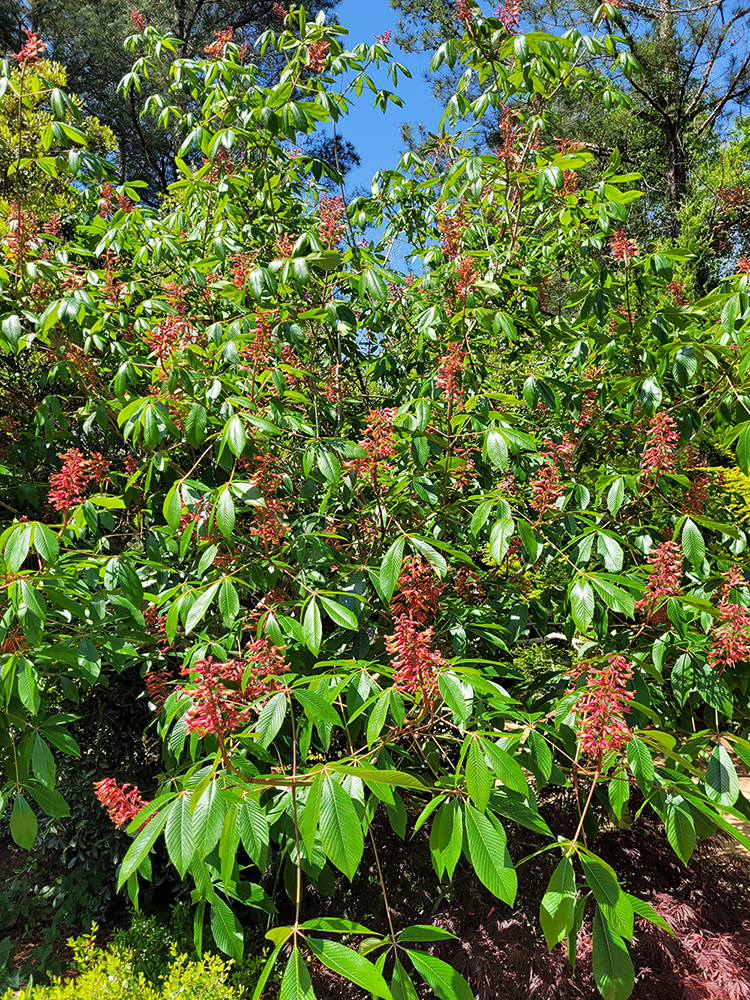
Red buckeye
Image courtesy of Cara Specht, SC Forestry Commission
Columbia - March 8, 2025
- White oak (Quercus alba)
White oak is a massive, long-lived stately tree with a wide-spreading, horizontally-branched crown that boasts an exquisite, wine-red fall leaf color that later fades to winter shades of brown. This native reaches grows to 80-100 feet in the wild and 60-80 feet tall and wide in the urban environment, providing ample shade for larger landscape spaces. Shiny, bright green leaves have finger-like lobes, and large, acorn fruits that are largely commonly consumed by squirrels, woodpeckers, turkey and white-tailed deer. Numerous butterflies use white oak as a host tree. Bark is ash-gray and scaly on young trees and ridged and platy on older trees. White oak is fairly adaptable, grows very well on most urban sites, preferring sites offering full sun and rich, well-drained soils.
- Bald cypress (Taxodium distichum)
Bald cypress is a large, needle-leaf, cone-bearing tree with a pyramidal shape, spreading crown and soft, feathery leaves. It reaches heights of 70-100 feet with narrower spread of 20-35 feet. Although this tree occurs in moist-wet soils, naturally, it is a superior selection in the urban environment, lending great versatility and tolerance of harsh, urban conditions, including heat, drought, diseases, and variable soil moisture. Bark is thin, fibrous, and light gray to reddish-brown. Small, one-inch, rounded cone fruits are produced each year, and fall color reveals a lovely, rich, bronze-reddish color. Bald cypress can be planted in full sun or partial shade.
- Southern Magnolia (Magnolia grandiflora)
Southern Magnolia is a beautiful, large canopy evergreen shade tree known for its colossal-sized creamy-white flowers and their sweet fragrance. Southern magnolia has a pyramidal form and is an extremely large tree, typically growing 50-100 feet in height and 30–40-foot spread. Glossy evergreen leaves are smooth and leather-like attach to deeply stout twigs and branches. Six-petaled, showy flowers are cup-shaped and grow to 8 inches. Flowers bloom in summer and extend into fall. Conelike seed pods develop after flowering that host large, bright red colored seeds that are favored by various species of birds and small mammals.

Southern Magnolia
Image courtesy of Davis Syndor - Carolina cherry laurel (Prunus caroliniana)
The Carolina cherry-laurel is a multi-stemmed shrub that can grow to 35’ tall. It can be planted in full sun or partial shade. It is moderately salt tolerant and drought tolerant once established. It is also deer tolerant. It will self-seed in the landscape, so it can be a great hedge or border tree. It attracts pollinators and birds with fragrant, white flowers in the spring.

Carolina cherry laurel
Image courtesy of James H. Miller & Ted Bodner, Southern Weed Science Society, Bugwood.org - Brandywine red maple (Acer rubrum 'Brandywine')
Red maple 'Brandywine' is a red maple cultivar between Acer rubrum x 'October Glory' and Acer rubrum x 'Autumn Blaze' that has long-lasting fall color that turns to a deep red-purple color in fall. It only produces male flowers with no risk of seedlings or fruit. It has high tolerance of leafhopper, a common pest of red maples. The height at 12 years is 25' with a spread of 12'. Eventually, the tree will grow to 35'-50' ft and will maintain its oval form.
- Winged elm (Ulmus alata)
A deciduous, fast-growing medium to large sized tree with oval to rounded form and distinctive corky, wing-like outcropping on twigs and branches. The mature size ranges from 40-60 feet height with canopy spread of 30-40 feet. Winged elm has rich, dark green, elliptically shaped leaves that feature a paler underside and a double-serrated (toothed) margin. Leaves are rich, dark green with a paler green underside and pubescent, sandpaper-like texture. The fall color is an attractive yellow. Small, rounded, lightweight samara fruit (one-seeded winged fruit) are produced each year. The attractive bark is gray, brown with flat ridges and fissures. Winged elm is a very adaptable tree, performing well in a range of soil conditions, including clay, loam, acidic or alkaline, wet or well-drained soils. It is especially tolerant of drought, compaction, and dry, rocky soils. Wood is strong and breakage resistant. Plant winged elm in full sun or part shade. Some structural pruning is needed to maintain a strong, central trunk. Winged elm makes a fine addition in the landscape as a nice, attractive shade tree and benefits wildlife, in particular, insectivorous birds, small mammals, and the Question Mark butterfly.
- Hazel adler (Alnus serrulata)
Hazel alder is a small, multi-trunked, deciduous tree with deep green leaves with serrated, wavy edges. Mature size of 10-15 feet. Also known as Smooth alder, this small shrubby tree is excellent for moist-wet soils as it grows naturally along edges of creeks, rivers, and ponds. Bark is shiny grayish-brown, smooth and fluted in appearance. Fall color is an attractive yellow with tinges of red. This native tree attracts songbirds, butterflies and other pollinators and can be planted in partial sun, partial shade, or full shade. Hazel alder is a robust little tree, tolerant of various site conditions, including clay, compaction, drought, erosion, heat, and occasional flooding.
- Sweetshrub (Calycanthus floridus)
Sweetshrub is a multi-stemmed deciduous native shrub noted for its bright green leaves, stout, upright stems, and fragrant showy scarlet-red flowers. This native shrub is often found growing near water and in shady forest understories and matures to a size of 6-12’ in height with similar spread. Plant sweetshrub in full sun for a denser shrub or partial shade for a lankier form. This species can flourish in full sun. Sweetshrub is adaptable to many different soil conditions, but prefers rich, well drained loamy soils. Large, aromatic flowers are spectacular each spring and have been compared to scents of strawberry, banana, and pineapple. Sweetshrub makes a great ornamental foundational shrub. Fall color is yellow. No serious disease issues.
- Buttonbush (Cephalanthus occidentalis)
Buttonbush is a native shrub that grows up to 10’ and spreads 6-8’. It naturally occurs in freshwater wetlands, so it thrives in moderate to wet soil with full sun to partial shade. If pruned, it can keep a round form. If left unpruned, it can serve as hedge or bordering plant. It is a great choice for pollinators, like hummingbirds, bees, and butterflies during its flowering season from March to August. Buttonbush has spherical white puffball flowers with yellow tips. It has small brown nuts that persist through the winter.
- American snowbell (Styrax americanus)
A large deciduous, slender-branched shrub or small tree with showy, white, bell-shaped flowers and a graceful, arching crown. Mature height ranges from 6-12 feet When in bloom, pendulous clusters of flowers abundantly cover the plant, exuding a sweetly fragrant aura. This native plant attracts many pollinators species of bees, butterflies, and moths. Plant in full sun to partial shade in acidic, well-drained or moist-wet soil.
- Hoptree (Ptelia trifoliata)
Hoptree is a small deciduous tree or large shrub that matures to a size of 10-20 feet in height and spread and has a bushy habit. It is commonly found on dry, rocky soils and on bluffs and ridges. Hoptree also occurs naturally in open woodlands and can be found along the coastal plain or up higher on river bluffs. Hoptree is named after its flat, rounded, paper-like fruit that is used as a hops alternative in the beer brewery industry. The fruits also serve as a great food source for birds and small mammals. Leaves are grouped in threes. Flowers are delicate greenish white born on clusters and noted by some as foul smelling. Hoptree is very adaptable but prefers well-drained, moist soil in partial shade. It will also tolerate full sun planting sites. Fall color is a greenish yellow. No serious disease issues.
Greenwood - March 15, 2025
- Hazel adler (Alnus serrulata)
Hazel alder is a small, multi-trunked, deciduous tree with deep green leaves with serrated, wavy edges. Mature size of 10-15 feet. Also known as Smooth alder, this small shrubby tree is excellent for moist-wet soils as it grows naturally along edges of creeks, rivers, and ponds. Bark is shiny grayish-brown, smooth and fluted in appearance. Fall color is an attractive yellow with tinges of red. This native tree attracts songbirds, butterflies and other pollinators and can be planted in partial sun, partial shade, or full shade. Hazel alder is a robust little tree, tolerant of various site conditions, including clay, compaction, drought, erosion, heat, and occasional flooding.
- Paw paw (Asimina triloba)
A small, short-trunked tree or large, multi-stemmed shrub with large, tropical-like leaves and edible yellow fruit. Paw paw matures to a size of 10-25 feet and can be planted in full sun or part shade. The large, deciduous leaves are bright green and thick, gradually altering to a yellow-green color in the fall. Deep purple, six-petal flowers emerge in the spring, though not particularly showy, are interesting, nonetheless. Yellow, cylindrical fruits add appeal to this small tree and are also enjoyed by a variety of wildlife, including possums, squirrels, raccoons and birds.
- American beautyberry (Callicarpa americana)
A large, native shrub known for its striking, iridescent pink to purple fruit that clings to its long, arching, woody branches. American Beautyberry typically grows to a height and spread of 3-5 feet, though it can reach a maximum height of 9 feet. Tiny, whiteish-pink flowers form in dense clusters at leaf bases around stems. Smooth bark appears reddish brown on younger stems later fading to a light brown color. Elliptically shaped leaves, popularly browsed by white-tailed deer, fade to a light green to yellow fall color. Seeds and berry clusters are important foods for many species of birds, particularly the Northern Bobwhite.
- Sweetshrub (Calycanthus floridus)
Sweetshrub is a multi-stemmed deciduous native shrub noted for its bright green leaves, stout, upright stems, and fragrant showy scarlet-red flowers. This native shrub is often found growing near water and in shady forest understories and matures to a size of 6-12’ in height with similar spread. Plant sweetshrub in full sun for a denser shrub or partial shade for a lankier form. This species can flourish in full sun. Sweetshrub is adaptable to many different soil conditions, but prefers rich, well drained loamy soils. Large, aromatic flowers are spectacular each spring and have been compared to scents of strawberry, banana, and pineapple. Sweetshrub makes a great ornamental foundational shrub. Fall color is yellow. No serious disease issues.
- American hornbeam (Carpinus caroliniana)
An aesthetically pleasing, short, stubby, deciduous tree with multiple leaders and extremely dense wood. Commonly referred to as “Musclewood” or “Ironwood,” American hornbeam reaches an average height of 30 feet with crown spread of 20-25 feet. Dark green, elliptically shaped leaves are shiny and have a toothed margin. Small, ribbed nutlet fruits are produced each season. Bark has a distinct blueish-gray tone, smooth texture and pronounced indentations similar in appearance to human “muscles.” Fall color is a bright, uplifting yellow color. This tree frequently grows naturally in moist soils along river and streambanks but also fares well on upland, drier sites. Hornbeam thrives in partial sun (2-6 hours of sunlight/day) and does best in loamy, sandy acidic soils. Ironwood also tolerates occasional flooding and is moderately resistant to deer. Avoid highly compacted sites and full sun.
- Buttonbush (Cephalanthus occidentalis)
Buttonbush is a native shrub that grows up to 10’ and spreads 6-8’. It naturally occurs in freshwater wetlands, so it thrives in moderate to wet soil with full sun to partial shade. If pruned, it can keep a round form. If left unpruned, it can serve as hedge or bordering plant. It is a great choice for pollinators, like hummingbirds, bees, and butterflies during its flowering season from March to August. Buttonbush has spherical white puffball flowers with yellow tips. It has small brown nuts that persist through the winter.
- Eastern redbud (Cercis canadensis)
A small native tree with short trunk and multiple stems and vase shape with mature size of 15-25 feet in height with similar spread. Redbud is adored in early spring for its stunning display of gorgeous purplish-pink flowers that decorate the branches. Its leaves are smooth, simple, and heart-shaped, and bark is dark brown grayish with a flaky texture. Considered a tough, urban tree tolerant of clay soils and periods of drought.
- White fringetree (Chionanthus virginicus)
The white fringetree is a small, deciduous tree that grows 12’-20’ tall, with a multi-stemmed rounded crown. It grows best and has the best blooms when planted in in full sun. Although it has the best foliage in partial shade. It is best to plant in well-drained soil, but it can tolerate clay soil. In late spring, fragrant flower clusters with white fringe-like petals appear. In late summer, birds and wildlife eat the clusters of olive-like berries. In fall, the leaves turn yellow.
- Persimmon (Diospyros virginiana)
Persimmon trees have an oval form and mature to a typical size of 20-35 feet in height with slightly smaller spread. This tree is known for its production of small, orange fruits and distinctive, gray, blocky bark. Spring flowers are attractive yellowish-green blooms. Fruits are small, rounded, 1-2,” orange and fleshy with a sweet, honey flavor. Trees bear fruit between 4 and 9 years old and attract an array of wildlife, including small animals, birds, deer, fox, and black bear.
- Yaupon holly (Ilex vomitoria)
A small evergreen tree with shiny green, elliptical-shaped leaves and strong, upright, dense branching, making it an ideal selection as a screening or privacy species. Yaupon holly typically matures to a size of 10-20 feet in height and spread of 8-12 feet. Growth rate can be slow to moderate. Copious amounts of attractive, bright red berries are produced by female trees, most popularly sold in nurseries. Yaupon holly is a versatile little tree that transplants easily and tolerates a range of soil types, including both dry and wet soils, drought, and occasional flooding. Plant in full sun or part shade.
- Florida anise tree (Illicium floridanum)
Anise tree is a medium-large evergreen shrub or small tree with upright form and delicate, deep-red fringe-like flowers. Showy spring flowers grow to one and a half-inch in size and contain aromatic compounds that repel insects, making this plant pest resistant. Evergreen leaves are thick and shiny, olive green in color and have an aromatic fragrance when crushed. Plant Anise tree in partial sun or full shade to prevent leaves from scorching in excessive hours of bright sunlight. It prefers moist, rich soil to grow and can also tolerates excessively wet sites or occasional flooding.
- Southern Magnolia (Magnolia grandiflora)
Southern Magnolia is a beautiful, large canopy evergreen shade tree known for its colossal-sized creamy-white flowers and their sweet fragrance. Southern magnolia has a pyramidal form and is an extremely large tree, typically growing 50-100 feet in height and 30–40-foot spread. Glossy evergreen leaves are smooth and leather-like attach to deeply stout twigs and branches. Six-petaled, showy flowers are cup-shaped and grow to 8 inches. Flowers bloom in summer and extend into fall. Conelike seed pods develop after flowering that host large, bright red colored seeds that are favored by various species of birds and small mammals.

Southern Magnolia
Image courtesy of Davis Syndor
